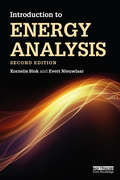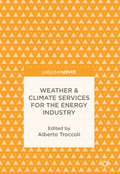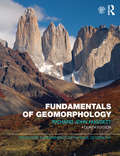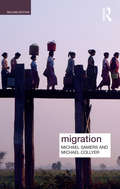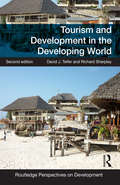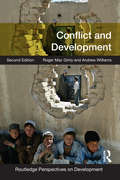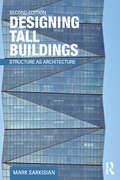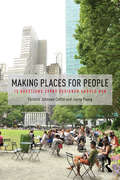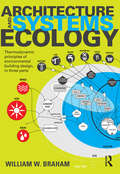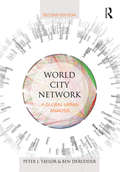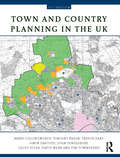- Table View
- List View
Introduction to Energy Analysis
by Kornelis Blok Evert NieuwlaarThe energy supply and demand system is of great importance for society, from economic, social, and ecological viewpoints. The last decade in particular has seen rapid changes in the world of energy systems, and it is therefore now an important area for study, academic research, and professional work. This textbook provides an introduction to energy analysis for those students who want to specialise in this challenging field. In comparison to other textbooks, this book provides a balanced treatment of complete energy systems, covering the demand side, the supply side, and the energy markets that connect these. The emphasis is very much on presenting a range of tools and methodologies that will help students find their way in analysing real world problems in energy systems. Featuring learning objectives, further readings and practical exercises in each chapter, An Introduction to Energy Analysis will be essential reading for upper-level undergraduate and postgraduate students with a background in the natural sciences and egineering. This book may also be useful for professionals dealing with energy issues, as a first introduction into the field.
Weather & Climate Services for the Energy Industry
by Alberto TroccoliThis open access book showcases the burgeoning area of applied research at the intersection between weather and climate science and the energy industry. It illustrates how better communication between science and industry can help both sides. By opening a dialogue, scientists can understand the broader context for their work and the energy industry is able to keep track of and implement the latest scientific advances for more efficient and sustainable energy systems. Weather & Climate Services for the Energy Industry considers the lessons learned in establishing an ongoing discussion between the energy industry and the meteorological community and how its principles and practises can be applied elsewhere. This book will be a useful guiding resource for research and early career practitioners concerned with the energy industry and the new field of research known as energy meteorology.
Weather & Climate Services for the Energy Industry
by Alberto TroccoliThis open access book showcases the burgeoning area of applied research at the intersection between weather and climate science and the energy industry. It illustrates how better communication between science and industry can help both sides. By opening a dialogue, scientists can understand the broader context for their work and the energy industry is able to keep track of and implement the latest scientific advances for more efficient and sustainable energy systems. Weather & Climate Services for the Energy Industry considers the lessons learned in establishing an ongoing discussion between the energy industry and the meteorological community and how its principles and practises can be applied elsewhere. This book will be a useful guiding resource for research and early career practitioners concerned with the energy industry and the new field of research known as energy meteorology.
Mobility (Key Ideas in Geography)
by Peter AdeyMobility aims to take the pulse of this enormously expanded and energetic field. It explores the breadth of the disciplinary areas mobility studies now encompass, examining the diverse conceptual and methodological approaches wielded within the field, and explores the utility of mobility to illuminate a cornucopia of mobile lives: from the mass movements of individuals within global processes such as migration and tourism, to homelessness and war; from the entangled relations caught up in the movement of disease, people and aid across borders, to the inability of someone to cross over a road. The new edition explores the more sustained elaboration of mobility studies within a wide variety of disciplinary approaches and subject matters. It echoes the growing internationalization of mobility research, reflected in diverse case studies from the Global South, South Asia, Latin America, the Caribbean and so far under-represented perspectives from China, Australasia, post-socialist Eastern Europe, the Middle East and elsewhere. The book also features an additional chapter on mobility studies, to survey and explore the diverse quality of the field, and methodologies, in order to reflect the growing diversity of methodological approaches to mobilities, from walk-alongs and critical cartography to the mobile arts. The book offers an accessible reading of the way mobility has been tackled and understood, neatly exploring and summarizing a topic that has exploded into different variations and nuances. The text allows scholars and students alike to grasp the central importance of ‘mobility’ to social, cultural, political, economic and everyday terrains by providing accessible writings on key authors within key ideas and case study boxes, suggested further readings and summaries, while at the same time making a significant contribution to scholarly writings and debates.
Fundamentals of Geomorphology
by Richard John HuggettThe new fourth edition of Fundamentals of Geomorphology continues to provide a comprehensive introduction to the subject by discussing the latest developments in the field, as well as covering the basics of Earth surface forms and processes. The revised edition has an improved logically cohesive structure, added recent material on Quaternary environments and landscapes, landscape evolution and tectonics, as well as updated information in fast-changing areas such as the application of dating techniques, digital terrain modelling, historical contingency, preglacial landforms, neocatastrophism, and biogeomorphology. The book begins with a consideration of the nature of geomorphology, process and form, history, and geomorphic systems, and moves on to discuss: Endogenic processes: structural landforms associated with plate tectonics and those associated with volcanoes, impact craters, and folds, faults, and joints. Exogenic processes: landforms resulting from, or influenced by, the exogenic agencies of weathering, running water, flowing ice and meltwater, ground ice and frost, the wind, and the sea; landforms developed on limestone; and long-term geomorphology, a discussion of ancient landforms, including palaeosurfaces, stagnant landscape features, and evolutionary aspects of landscape change. Featuring over 400 illustrations, diagrams, and tables, Fundamentals of Geomorphology provides a stimulating and innovative perspective on the key topics and debates within the field of geomorphology. Written in an accessible and lively manner, and providing guides to further reading, chapter summaries, and an extensive glossary of key terms, this is an indispensable undergraduate level textbook for students of physical geography.
Fundamentals of Geomorphology
by Richard John HuggettThe new fourth edition of Fundamentals of Geomorphology continues to provide a comprehensive introduction to the subject by discussing the latest developments in the field, as well as covering the basics of Earth surface forms and processes. The revised edition has an improved logically cohesive structure, added recent material on Quaternary environments and landscapes, landscape evolution and tectonics, as well as updated information in fast-changing areas such as the application of dating techniques, digital terrain modelling, historical contingency, preglacial landforms, neocatastrophism, and biogeomorphology. The book begins with a consideration of the nature of geomorphology, process and form, history, and geomorphic systems, and moves on to discuss: Endogenic processes: structural landforms associated with plate tectonics and those associated with volcanoes, impact craters, and folds, faults, and joints. Exogenic processes: landforms resulting from, or influenced by, the exogenic agencies of weathering, running water, flowing ice and meltwater, ground ice and frost, the wind, and the sea; landforms developed on limestone; and long-term geomorphology, a discussion of ancient landforms, including palaeosurfaces, stagnant landscape features, and evolutionary aspects of landscape change. Featuring over 400 illustrations, diagrams, and tables, Fundamentals of Geomorphology provides a stimulating and innovative perspective on the key topics and debates within the field of geomorphology. Written in an accessible and lively manner, and providing guides to further reading, chapter summaries, and an extensive glossary of key terms, this is an indispensable undergraduate level textbook for students of physical geography.
Integrating Building Performance with Design: An Architecture Student’s Guidebook
by Elizabeth J. GrantIntegrating Building Performance with Design shows you the importance of designing for building performance early in your architectural design process. The book offers you simple tools and exercises, along with examples of built professional work and successful student projects illustrated by more than 100 full color images to help you with your work. Topics include site, solar orientation, thermal comfort, building enclosure, daylighting, passive heating and cooling, active heating and cooling, indoor air quality, stormwater, and rainwater harvesting.?
Migration (Key Ideas in Geography)
by Michael Samers Michael CollyerWhile the subject of migration has received enormous attention in academic journals and books across the social sciences, introductory texts on the matter are few and far between. Even fewer books have explored migration through a critical and explicit engagement with spatial concepts. Now in its second edition, Migration remains the only text in more than a decade that emphasizes how geographical or spatial concepts can be used critically to understand migration. The multi-disciplinary text draws on insights from human geography, political science, social anthropology, sociology, and to a lesser extent economics. All of the chapters focus on key terms, theories, concepts, and issues concerning migration and immigration. The book argues that in the context of migration, two opposing ‘spatial positions’ have emerged in the wake of the critique of ‘methodological nationalism’. On one hand is the significance of ‘transnationalism’, and on the other, the importance of ‘sub-national’ or local processes. Both require more nuance and integration, while many of the concepts and theories which have thus far neglected space or have not been ‘treated’ spatially, need to be re-written with space in mind. Pedagogically the text combines a carefully defined structure, accessible language, boxes that explore case studies of migrant-related experiences in particular places, annotated suggestions for further reading, useful websites and relevant films and summary questions for student learning at the end of each chapter. Migration provides a critical, multi-disciplinary, advanced, and theoretically informed introduction to migration and immigration. Revised and updated with new material, new maps and illustrations and an accompanying website (https://migration2ndedition.wordpress.com/), it continues to be aimed at advanced undergraduates and Masters-level graduate students undertaking courses on migration and immigration.
Tourism and Development in the Developing World (Routledge Perspectives on Development)
by Richard Sharpley David J. TelferTourism is widely considered to be an important factor in socio-economic development, particularly in less developed countries. However, despite almost universal recognition of tourism’s development potential, the extent to which economic and social progress is linked to the growth of a country’s tourism sector remains the subject of intense debate. Tourism and Development in the Developing World offers a thorough overview of the tourism-development relationship. Focusing specifically on the less developed world and drawing on contemporary case studies, this updated second edition questions widely-held assumptions on the role of tourism in development and seeks to highlight the challenges faced by destinations seeking to achieve development through tourism. The introductory chapter establishes the foundation for the book, exploring the meaning and objectives of development, reviewing theoretical perspectives on the developmental process, and assessing the reasons why less developed countries are attracted to tourism as a development option. The concept of sustainable development, as the most widely adopted contemporary model of development, is then introduced and its links with tourism critically assessed. Subsequent chapters explore the key issues associated with tourism and development, including the rise of globalization; the tourism planning and development process; the relationship between tourism and communities within which it is developed; the management implications of trends in the demand for and uptake of tourism; and an analysis of the consequences of tourism development for destination environments, economies and societies. A new chapter considers the challenges of climate change, sustainability of resource supply (oil, water and food), global economic instability, political instability and changing demographics. Finally, the issues raised throughout the book are drawn together in a concluding chapter that assesses the tourism and development ‘dilemma’. Combining an overview of essential concepts, theories and knowledge with an analysis of contemporary issues and debates in tourism and development, this new edition will be an invaluable resource for those investigating tourism issues in developing countries. The book will be of interest to students of tourism, development, geography and area studies, international relations and politics, and sociology. ?
Conservation and Development (Routledge Perspectives on Development)
by Andrew Newsham Shonil BhagwatConservation and development share an intertwined history dating back to at least the 1700s. But what are the prospects for reconciling the two, and how far have we come with this project? This book explores these questions through a detailed consideration of the past, present and future of the relationship between conservation and development. Bringing to bear conceptual resources from political ecology, social-ecological systems thinking and science and technology studies, Conservation and Development sets this relationship against the background of the political and economic processes implicated in environmental degradation and poverty alike. Whilst recognising that the need for reconciling conservation and development processes remains as compelling as ever, it demonstrates why trade-offs are more frequently encountered in practice than synergies. It also flags alternative visions for conservation and development obscured or ignored by current framings and priorities. Bringing together policy and theory, Conservation and Development is an essential resource for undergraduate and postgraduate students and a useful reference for researchers in related fields. Each chapter contains a reading guide with discussion questions. The text is enlivened by a number of new case studies from around the world. A must-read for anyone interested in understanding the history, current state, and projections for future shifts in the relationship between conservation and development.
Conflict and Development (Routledge Perspectives on Development)
by Andrew Williams Roger Mac GintyIn the five years since the first edition of Conflict and Development was published the awareness of the relationship between conflicts and development has grown exponentially. Developmental factors can act as a trigger for violence, as well as for ending violence and for triggering post-conflict reconstruction. The book explores the complexity of the links between violent conflict (usually civil wars) and development, under-development and uneven development. The second edition incorporates significant changes in the field including the G7+ initiative, the New Deal on Fragile States, World Trade talks, major policy documents from the UNDP and World Bank and updates on the Afghanistan and Iraq wars.
Designing Tall Buildings: Structure as Architecture
by Mark SarkisianThis second edition of Designing Tall Buildings, an accessible reference to guide you through the fundamental principles of designing high-rises, features two new chapters, additional sections, 400 images, project examples, and updated US and international codes. Each chapter focuses on a theme central to tall-building design, giving a comprehensive overview of the related architecture and structural engineering concepts. Author Mark Sarkisian, PE, SE, LEED® AP BD+C, provides clear definitions of technical terms and introduces important equations, gradually developing your knowledge. Projects drawn from SOM’s vast portfolio of built high-rises, many of which Sarkisian engineered, demonstrate these concepts. This book advises you to consider the influence of a particular site's geology, wind conditions, and seismicity. Using this contextual knowledge and analysis, you can determine what types of structural solutions are best suited for a tower on that site. You can then conceptualize and devise efficient structural systems that are not only safe, but also constructible and economical. Sarkisian also addresses the influence of nature in design, urging you to integrate structure and architecture for buildings of superior performance, sustainability, and aesthetic excellence.
Designing Tall Buildings: Structure as Architecture
by Mark SarkisianThis second edition of Designing Tall Buildings, an accessible reference to guide you through the fundamental principles of designing high-rises, features two new chapters, additional sections, 400 images, project examples, and updated US and international codes. Each chapter focuses on a theme central to tall-building design, giving a comprehensive overview of the related architecture and structural engineering concepts. Author Mark Sarkisian, PE, SE, LEED® AP BD+C, provides clear definitions of technical terms and introduces important equations, gradually developing your knowledge. Projects drawn from SOM’s vast portfolio of built high-rises, many of which Sarkisian engineered, demonstrate these concepts. This book advises you to consider the influence of a particular site's geology, wind conditions, and seismicity. Using this contextual knowledge and analysis, you can determine what types of structural solutions are best suited for a tower on that site. You can then conceptualize and devise efficient structural systems that are not only safe, but also constructible and economical. Sarkisian also addresses the influence of nature in design, urging you to integrate structure and architecture for buildings of superior performance, sustainability, and aesthetic excellence.
Making Places for People: 12 Questions Every Designer Should Ask
by Christie Johnson Coffin Jenny Young** Honorable Mention at the 2019 ERDA Great Places Awards ** Making Places for People explores twelve social questions in environmental design. Authors Christie Johnson Coffin and Jenny Young bring perspectives from practice and teaching to challenge assumptions about how places meet human needs. The book reveals deeper complexities in addressing basic questions, such as: What is the story of this place? What logic orders it? How big is it? How sustainable is it? Providing an overview of a growing body of knowledge about people and places, Making Places for People stimulates curiosity and further discussion. The authors argue that critical understanding of the relationships between people and their built environments can inspire designs that better contribute to health, human performance, and social equity—bringing meaning and delight to people’s lives.
Architecture and Systems Ecology: Thermodynamic Principles of Environmental Building Design, in three parts
by William W. BrahamModern buildings are both wasteful machines that can be made more efficient and instruments of the massive, metropolitan system engendered by the power of high-quality fuels. A comprehensive method of environmental design must reconcile the techniques of efficient building design with the radical urban and economic reorganization that we face. Over the coming century, we will be challenged to return to the renewable resource base of the eighteenth-century city with the knowledge, technologies, and expectations of the twenty-first-century metropolis. This book explores the architectural implications of systems ecology, which extends the principles of thermodynamics from the nineteenth-century focus on more efficient machinery to the contemporary concern with the resilient self-organization of ecosystems. Written with enough technical material to explain the methods, it does not include in-text equations or calculations, relying instead on the energy system diagrams to convey the argument. Architecture and Systems Ecology has minimal technical jargon and an emphasis on intelligible design conclusions, making it suitable for architecture students and professionals who are engaged with the fundamental issues faced by sustainable design. The energy systems language provides a holistic context for the many kinds of performance already evaluated in architecture—from energy use to material selection and even the choice of building style. It establishes the foundation for environmental principles of design that embrace the full complexity of our current situation. Architecture succeeds best when it helps shape, accommodate, and represent new ways of living together.
Basic Offshore Safety: Safety induction and emergency training for new entrants to the offshore oil and gas industry
by Abdul KhaliqueComprehensive insight into the offshore oil and gas industry for those intending to choose it as a career Full syllabus coverage for OPITO BOSIET, FOET, MIST and IMIST courses Produced in full colour with over 180 images Basic Offshore Safety covers everything that newcomers to the offshore oil and gas industry need to know ?prior to travelling offshore or when attending OPITO's Basic Offshore Safety Induction and Emergency Training (BOSIET), Minimum Industry Safety Training (MIST), Further Offshore Emergency Training (FOET) and International MIST courses. Primarily focused on the oil industry, this book introduces readers to the key safety topics in the offshore support vessel industry and common to the renewable industry. Written in easy to follow steps and including references to both the legislation and guidance where relevant, Abdul Khalique walks the reader through the hazards they are likely to encounter when travelling to, from or working offshore, showing how to minimise risks and deal with any issues that may arise at any stage of the work.
Basic Offshore Safety: Safety induction and emergency training for new entrants to the offshore oil and gas industry
by Abdul KhaliqueComprehensive insight into the offshore oil and gas industry for those intending to choose it as a career Full syllabus coverage for OPITO BOSIET, FOET, MIST and IMIST courses Produced in full colour with over 180 images Basic Offshore Safety covers everything that newcomers to the offshore oil and gas industry need to know ?prior to travelling offshore or when attending OPITO's Basic Offshore Safety Induction and Emergency Training (BOSIET), Minimum Industry Safety Training (MIST), Further Offshore Emergency Training (FOET) and International MIST courses. Primarily focused on the oil industry, this book introduces readers to the key safety topics in the offshore support vessel industry and common to the renewable industry. Written in easy to follow steps and including references to both the legislation and guidance where relevant, Abdul Khalique walks the reader through the hazards they are likely to encounter when travelling to, from or working offshore, showing how to minimise risks and deal with any issues that may arise at any stage of the work.
A Practical Guide to the Rules of the Road: For OOW, Chief Mate and Master Students
by Farhan SaeedA self-teaching aid that covers International regulations for preventing collision at sea 1972 (Colregs) or Rules of the Road, including navigation lights and related situations that could be asked within the Maritime and Coastguard Agency oral examinations for the deck certificate of competency. This book is divided into two sections. The first section contains simple explanations of the Rules of the Road, while the second section covers more than sixty situations, exam questions and model answers. Interactive navigation light identification software is also available on a companion website to offer further testing before examination. All questions are asked randomly, and will help prepare you for the oral exam. Self-teaching guide to the International regulations for preventing collision at sea 1972 (Colregs) / Maritime Coastguard Agency (MCA) Rules of the Road oral examinations Scenarios, questions and model answers help you prepare for the examination Interactive navigation light identification software on a companion website allows students to test themselves before entering exams. Visit the website at www.seamanshiptutor.com.
World City Network: A global urban analysis
by Peter J. Taylor Ben DerudderWith the advent of multinational corporations, the traditional urban service function has 'gone global'. In order to provide services to globalizing corporate clients, the offices of major financial and business service firms across the world have generated networks of work. It is the myriad of flows between office towers in different metropolitan centres that has produced a world city network. Taylor and Derudder's unique and illuminating book provides both an update and a substantial revision of the first edition that was published in 2004. It provides a comprehensive and systematic description and analysis of the world city network as the 'skeleton' upon which contemporary globalization has been built. Through an analysis of the intra-company flows of 175 leading global service firms across 526 cities in 2012, this book assesses cities in terms of their overall network connectivity, the regional configurations they form, and their changing position in the period 2000-12. Results are used to reflect on cities and city/state relations in the context of the global ecological and economic crisis. Written by two of the foremost authorities on the subject, this book provides a much-needed mapping of the connecting relationships between world cities, and will be a valuable resource for students of urban studies, geography, sociology and planning.
Mineral Economics and Policy
by John E. Tilton Juan Ignacio GuzmánThis textbook provides an introduction to the field of mineral economics and its use in understanding the behaviour of mineral commodity markets and in assessing both public and corporate policies in this important economic sector. The focus is on metal and non-metallic commodities rather than oil, coal, and other energy commodities. The work draws on John Tilton's teaching experience over the last 30 years at the Colorado School of Mines and the Catholic University of Chile, as well as short courses for RioTinto and other mining companies. This is combined with the professional consulting and academic research of Juan Ignacio Guzmán over the past decade, in order to demonstrate the industry application of the economic principles described in the earlier chapters. The book should be an ideal text for graduate and undergraduate students in the fields of mining engineering and natural resource economics and policy. It should also be of interest to professionals and investors in mining and commodity markets, and those undertaking continuing education in the mineral sector.
Introducing Architectural Tectonics: Exploring the Intersection of Design and Construction
by Chad SchwartzIntroducing Architectural Tectonics is an exploration of the poetics of construction. Tectonic theory is an integrative philosophy examining the relationships formed between design, construction, and space while creating or experiencing a work of architecture. In this text, author Chad Schwartz presents an introductory investigation into tectonic theory, subdividing it into distinct concepts in order to make it accessible to beginning and advanced students alike. The book centers on the tectonic analysis of twenty contemporary works of architecture located in eleven countries including Germany, Italy, United States, Chile, Japan, Bangladesh, Spain, and Australia and designed by such notable architects as Tadao Ando, Herzog & de Meuron, Kengo Kuma, Olson Kundig, and Peter Zumthor. Although similarities do exist between the projects, their distinctly different characteristics – location and climate, context, size, program, construction methods – and range of interpretations of tectonic expression provide the most significant lessons of the book, helping you to understand tectonic theory. Written in clear, accessible language, these investigations examine the poetic creation of architecture, showing you lessons and concepts that you can integrate into your own work, whether studying in a university classroom or practicing in a professional office.
Town and Country Planning in the UK
by Barry Cullingworth Vincent Nadin Trevor Hart Simin Davoudi John Pendlebury Geoff Vigar David Webb Tim TownshendTown and country planning has never been more important to the UK, nor more prominent in national debate. Planning generates great controversy: whether it’s spending £80m and four years’ inquiry into Heathrow’s Terminal 5, or the 200 proposed wind turbines in the Shetland Isles. On a smaller scale telecoms masts, take-aways, house extensions, and even fences are often the cause of local conflict. Town and Country Planning in the UK has been extensively revised by a new author group. This 15th Edition incorporates the major changes to planning introduced by the coalition government elected in 2010, particularly through the National Planning Policy Framework and associated practice guidance and the Localism Act. It provides a critical discussion of the systems of planning, the procedures for managing development and land use change, and the mechanisms for implementing policy and proposals. It reviews current policy for sustainable development and the associated economic, social and environmental themes relevant to planning in both urban and rural contexts. Contemporary arrangements are explained with reference to their historical development, the influence of the European Union, the roles of central and local government, and developing social and economic demands for land use change. Detailed consideration is given to • the nature of planning and its historical evolution • the role of the EU, central, regional and local government • mechanisms for developing policy, and managing these changes • policies for guiding and delivering housing and economic development • sustainable development principles for planning, including pollution control • the importance of design in planning • conserving the heritage • community engagement in planning The many recent changes to the system are explained in detail – the new national planning policy framework; the impact of the loss of the regional tier in planning and of the insertion of neighbourhood level planning; the transition from development control to development management; the continued and growing importance of environmental matters in planning; community engagement; partnership working; changes to planning gain and the introduction of the Community Infrastructure Levy; and new initiatives across a number of other themes. Notes on further reading are provided and at the end of the book there is an extensive bibliography, maintaining its reputation as the ‘bible’ of British planning.
Town and Country Planning in the UK
by Barry Cullingworth Vincent Nadin Trevor Hart Simin Davoudi John Pendlebury Geoff Vigar David Webb Tim TownshendTown and country planning has never been more important to the UK, nor more prominent in national debate. Planning generates great controversy: whether it’s spending £80m and four years’ inquiry into Heathrow’s Terminal 5, or the 200 proposed wind turbines in the Shetland Isles. On a smaller scale telecoms masts, take-aways, house extensions, and even fences are often the cause of local conflict. Town and Country Planning in the UK has been extensively revised by a new author group. This 15th Edition incorporates the major changes to planning introduced by the coalition government elected in 2010, particularly through the National Planning Policy Framework and associated practice guidance and the Localism Act. It provides a critical discussion of the systems of planning, the procedures for managing development and land use change, and the mechanisms for implementing policy and proposals. It reviews current policy for sustainable development and the associated economic, social and environmental themes relevant to planning in both urban and rural contexts. Contemporary arrangements are explained with reference to their historical development, the influence of the European Union, the roles of central and local government, and developing social and economic demands for land use change. Detailed consideration is given to • the nature of planning and its historical evolution • the role of the EU, central, regional and local government • mechanisms for developing policy, and managing these changes • policies for guiding and delivering housing and economic development • sustainable development principles for planning, including pollution control • the importance of design in planning • conserving the heritage • community engagement in planning The many recent changes to the system are explained in detail – the new national planning policy framework; the impact of the loss of the regional tier in planning and of the insertion of neighbourhood level planning; the transition from development control to development management; the continued and growing importance of environmental matters in planning; community engagement; partnership working; changes to planning gain and the introduction of the Community Infrastructure Levy; and new initiatives across a number of other themes. Notes on further reading are provided and at the end of the book there is an extensive bibliography, maintaining its reputation as the ‘bible’ of British planning.
Creativity (Key Ideas in Geography)
by Harriet HawkinsCreativity, whether lauded as the oil of the 21st century, touted as a driver of international policy, or mobilised by activities, has been very much part of the zeitgeist of the last few decades. Offering the first accessible, but conceptually sophisticated account of the critical geographies of creativity, this title provides an entry point to the diverse ways in which creativity is conceptualized as a practice, promise, force, concept and rhetoric. It proffers these critical geographies as the means to engage with the relations and tensions between a range of forms of arts and cultural production, the cultural economy and vernacular, mundane and everyday creative practices. Exploring a series of sites, Creativity examines theoretical and conceptual questions around the social, economic, cultural, political and pedagogic imperatives of the geographies of creativity, using these geographies as a lens to cohere broader interdisciplinary debates. Central concepts, cutting-edge research and methodological debates are made accessible with the use of inset boxes that present key ideas, case studies and research. The text draws together interdisciplinary perspectives on creativity, enabling scholars and students within and without Geography to understand and engage with the critical geographies of creativity, their breadth and potential. The volume will prove essential reading for undergraduate and post-graduate students of creativity, cultural geography, the creative economy, cultural industries and heritage.
Introduction to Rural Planning: Economies, Communities and Landscapes
by Nick Gallent Iqbal Hamiduddin Meri Juntti Sue Kidd Dave ShawIntroduction to Rural Planning: Economies, Communities and Landscapes provides a critical analysis of the key challenges facing rural places and the ways that public policy and community action shape rural spaces.? The second edition provides an examination of the composite nature of ‘rural planning’, which combines land-use and spatial planning elements with community action, countryside management and the projects and programmes of national and supra-national agencies and organisations. It also offers a broad analysis of entrepreneurial social action as a shaper of rural outcomes, with particular coverage of the localism agenda and Neighbourhood Planning in England. With a focus on accessibility and rural transport provision, this book examines the governance arrangements needed to deliver integrated solutions spanning urban and rural places. Through an examination of the ecosystem approach to environmental planning, it links the procurement of ecosystem services to the global challenges of habitat degradation and loss, climate change and resource scarcity and management. A valuable resource for students of planning, rural development and rural geography, Introduction to Rural Planning aims to make sense of current rural challenges and planning approaches, evaluating the currency of the ‘rural’ label in the context of global urbanisation, arguing that rural spaces are relational spaces characterised by critical production and consumption tensions.?
